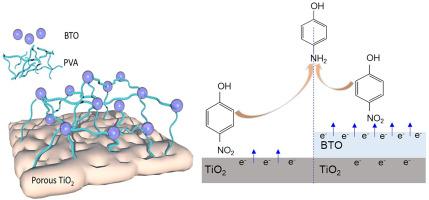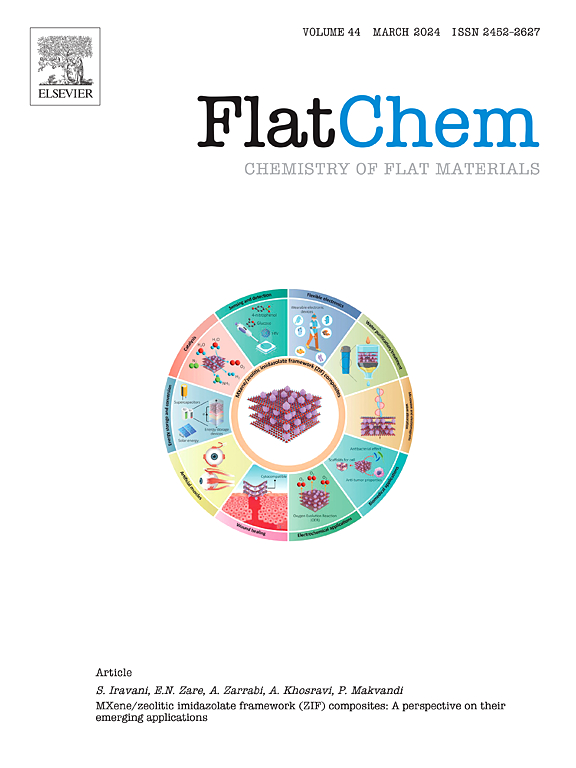在TiO2上均匀形成独特的BaTiO3/PVA,增强了4-硝基苯酚的光催化还原
IF 6.2
3区 材料科学
Q2 CHEMISTRY, PHYSICAL
引用次数: 0
摘要
本研究研究了在TiO2层上均匀沉积BaTiO3 (BTO)以达到光催化还原4-硝基苯酚的目的。为此,提出了一种在碱性电解液中进行等离子体电解和在BTO/聚乙烯醇(PVA)配方中进行自旋镀膜的两步法,其中BTO似乎很容易与PVA配合。由于PVA作为高分子封盖剂在防止BTO局部团聚和促进BTO稳定附着在多孔TiO2层上作为支撑平台等方面发挥了重要作用,因此BTO/PVA@TiO2催化剂具有优异的表面反应性,可催化4-硝基苯酚还原为4-氨基苯酚,在可见光照射下10 min内还原效率可达90%。BTO/PVA@TiO2样品的表观速率常数比多孔TiO2样品高一个数量级。这一发现主要归因于活性BTO颗粒与TiO2之间光电行为和电荷转移的改善。本文章由计算机程序翻译,如有差异,请以英文原文为准。

Uniform formation of distinctive BaTiO3/PVA on TiO2 responsible for enhanced photocatalytic reduction in 4-nitrophenol
This study investigated the uniform deposition of BaTiO3 (BTO) formed on TiO2 layer to attain photocatalytic reduction of 4-nitrophenol. To this end, a two-step method consisting of plasma electrolysis in the alkaline electrolyte and spin coating in the BTO/polyvinyl alcohol (PVA) recipe where BTO appeared to be coordinated readily with PVA was proposed. Since PVA would played important roles in preventing the local agglomeration of BTO as polymeric capping agent as well as facilitating the stable attachment of BTO on porous TiO2 layer as supporting platform, the BTO/PVA@TiO2 catalyst would exhibit the excellent surface reactivity for catalytic reduction from 4-nitrophenol to 4-aminophenol, achieving the efficiency of 90 % in 10 min under the visible light irradiation. It is also found that the apparent rate constant of BTO/PVA@TiO2 sample was higher by one-order than that of porous TiO2 counterpart. This finding was attributed mainly to the improvement in photo-electrochemical behavior and charge transfer between active BTO particles and TiO2.
求助全文
通过发布文献求助,成功后即可免费获取论文全文。
去求助
来源期刊

FlatChem
Multiple-
CiteScore
8.40
自引率
6.50%
发文量
104
审稿时长
26 days
期刊介绍:
FlatChem - Chemistry of Flat Materials, a new voice in the community, publishes original and significant, cutting-edge research related to the chemistry of graphene and related 2D & layered materials. The overall aim of the journal is to combine the chemistry and applications of these materials, where the submission of communications, full papers, and concepts should contain chemistry in a materials context, which can be both experimental and/or theoretical. In addition to original research articles, FlatChem also offers reviews, minireviews, highlights and perspectives on the future of this research area with the scientific leaders in fields related to Flat Materials. Topics of interest include, but are not limited to, the following: -Design, synthesis, applications and investigation of graphene, graphene related materials and other 2D & layered materials (for example Silicene, Germanene, Phosphorene, MXenes, Boron nitride, Transition metal dichalcogenides) -Characterization of these materials using all forms of spectroscopy and microscopy techniques -Chemical modification or functionalization and dispersion of these materials, as well as interactions with other materials -Exploring the surface chemistry of these materials for applications in: Sensors or detectors in electrochemical/Lab on a Chip devices, Composite materials, Membranes, Environment technology, Catalysis for energy storage and conversion (for example fuel cells, supercapacitors, batteries, hydrogen storage), Biomedical technology (drug delivery, biosensing, bioimaging)
 求助内容:
求助内容: 应助结果提醒方式:
应助结果提醒方式:


